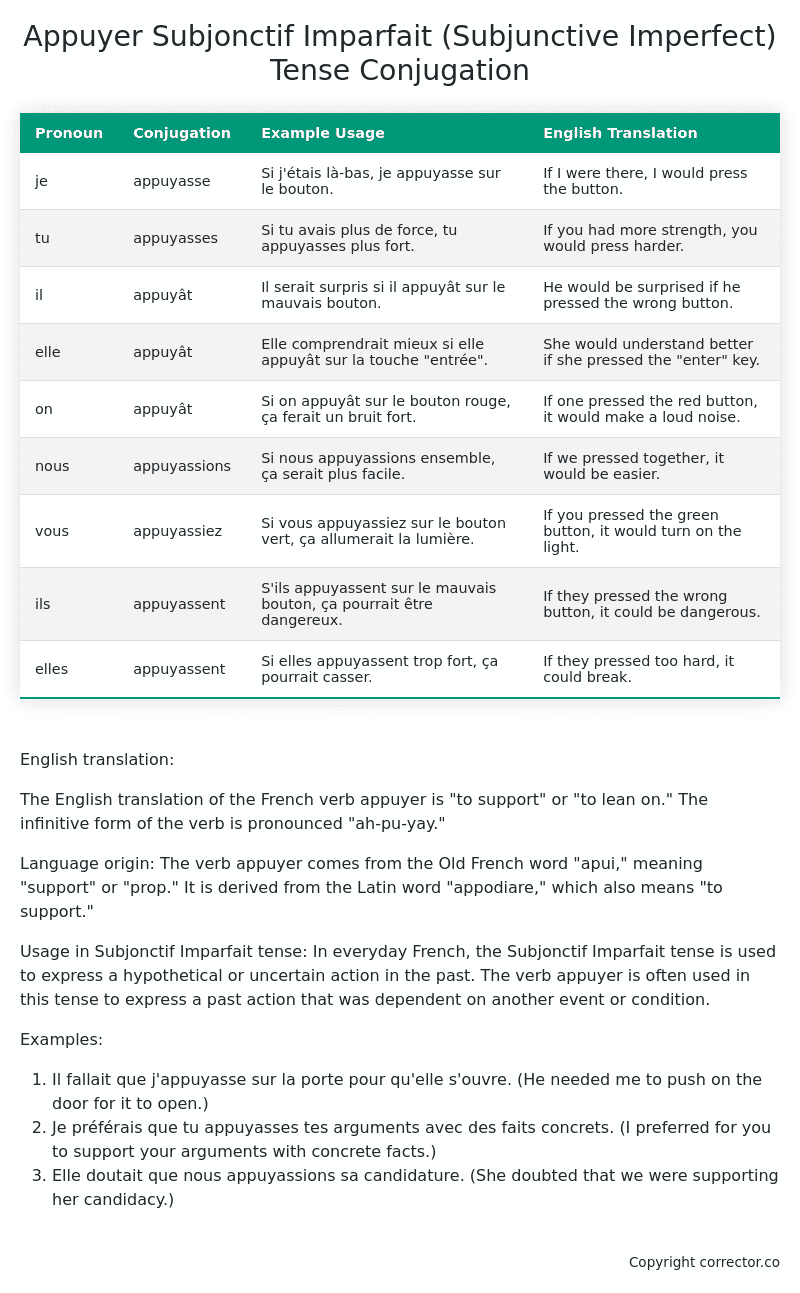Subjonctif Imparfait (Subjunctive Imperfect) Tense Conjugation of the French Verb appuyer
Introduction to the verb appuyer
English translation:
The English translation of the French verb appuyer is “to support” or “to lean on.” The infinitive form of the verb is pronounced “ah-pu-yay.”
Language origin:
The verb appuyer comes from the Old French word “apui,” meaning “support” or “prop.” It is derived from the Latin word “appodiare,” which also means “to support.”
Usage in Subjonctif Imparfait tense:
In everyday French, the Subjonctif Imparfait tense is used to express a hypothetical or uncertain action in the past. The verb appuyer is often used in this tense to express a past action that was dependent on another event or condition.
Examples:
- Il fallait que j’appuyasse sur la porte pour qu’elle s’ouvre.
(He needed me to push on the door for it to open.) - Je préférais que tu appuyasses tes arguments avec des faits concrets.
(I preferred for you to support your arguments with concrete facts.) - Elle doutait que nous appuyassions sa candidature.
(She doubted that we were supporting her candidacy.)
Table of the Subjonctif Imparfait (Subjunctive Imperfect) Tense Conjugation of appuyer
| Pronoun | Conjugation | Example Usage | English Translation |
|---|---|---|---|
| je | appuyasse | Si j’étais là-bas, je appuyasse sur le bouton. | If I were there, I would press the button. |
| tu | appuyasses | Si tu avais plus de force, tu appuyasses plus fort. | If you had more strength, you would press harder. |
| il | appuyât | Il serait surpris si il appuyât sur le mauvais bouton. | He would be surprised if he pressed the wrong button. |
| elle | appuyât | Elle comprendrait mieux si elle appuyât sur la touche “entrée”. | She would understand better if she pressed the “enter” key. |
| on | appuyât | Si on appuyât sur le bouton rouge, ça ferait un bruit fort. | If one pressed the red button, it would make a loud noise. |
| nous | appuyassions | Si nous appuyassions ensemble, ça serait plus facile. | If we pressed together, it would be easier. |
| vous | appuyassiez | Si vous appuyassiez sur le bouton vert, ça allumerait la lumière. | If you pressed the green button, it would turn on the light. |
| ils | appuyassent | S’ils appuyassent sur le mauvais bouton, ça pourrait être dangereux. | If they pressed the wrong button, it could be dangerous. |
| elles | appuyassent | Si elles appuyassent trop fort, ça pourrait casser. | If they pressed too hard, it could break. |
Other Conjugations for Appuyer.
Le Present (Present Tense) Conjugation of the French Verb appuyer
Imparfait (Imperfect) Tense Conjugation of the French Verb appuyer
Passé Simple (Simple Past) Tense Conjugation of the French Verb appuyer
Passé Composé (Present Perfect) Tense Conjugation of the French Verb appuyer
Futur Simple (Simple Future) Tense Conjugation of the French Verb appuyer
Futur Proche (Near Future) Tense Conjugation of the French Verb appuyer
Plus-que-parfait (Pluperfect) Tense Conjugation of the French Verb appuyer
Passé Antérieur (Past Anterior) Tense Conjugation of the French Verb appuyer
Futur Antérieur (Future Anterior) Tense Conjugation of the French Verb appuyer
Subjonctif Présent (Subjunctive Present) Tense Conjugation of the French Verb appuyer
Subjonctif Passé (Subjunctive Past) Tense Conjugation of the French Verb appuyer
Subjonctif Imparfait (Subjunctive Imperfect) Tense Conjugation of the French Verb appuyer (this article)
Subjonctif Plus-que-parfait (Subjunctive Pluperfect) Tense Conjugation of the French Verb appuyer
Conditionnel Présent (Conditional Present) Tense Conjugation of the French Verb appuyer
Conditionnel Passé (Conditional Past) Tense Conjugation of the French Verb appuyer
L’impératif Présent (Imperative Present) Tense Conjugation of the French Verb appuyer
L’infinitif Présent (Infinitive Present) Tense Conjugation of the French Verb appuyer
Struggling with French verbs or the language in general? Why not use our free French Grammar Checker – no registration required!
Get a FREE Download Study Sheet of this Conjugation 🔥
Simply right click the image below, click “save image” and get your free reference for the appuyer Subjonctif Imparfait tense conjugation!

Appuyer – About the French Subjonctif Imparfait (Subjunctive Imperfect) Tense
Formation
Common Everyday Usage Patterns
Interactions with Other Tenses
Subjonctif Présent
Indicatif Passé Composé
Conditional
Conditional Perfect
Summary
I hope you enjoyed this article on the verb appuyer. Still in a learning mood? Check out another TOTALLY random French verb conjugation!


